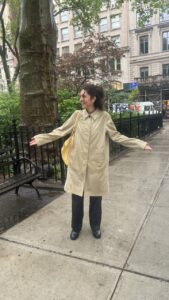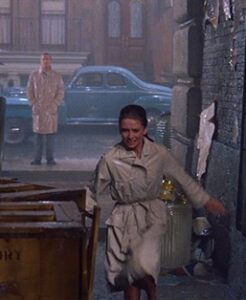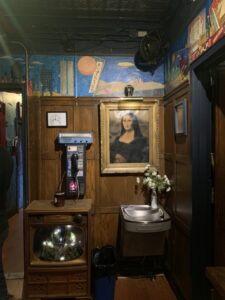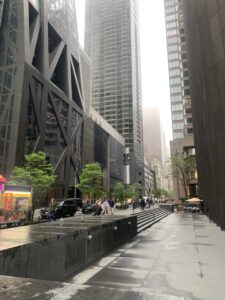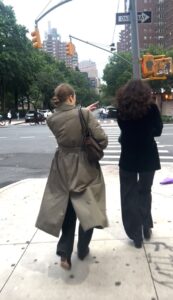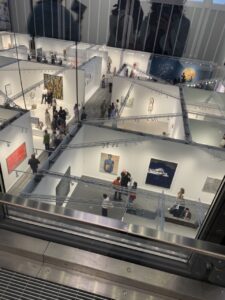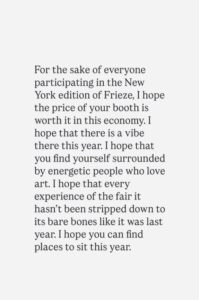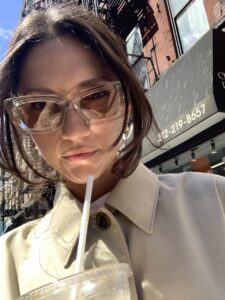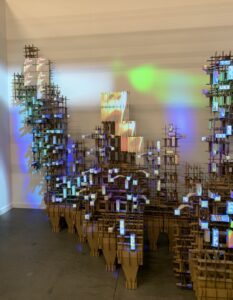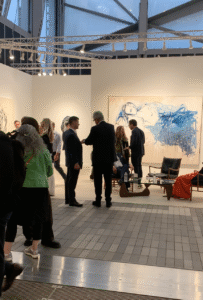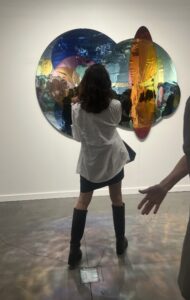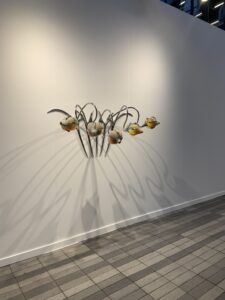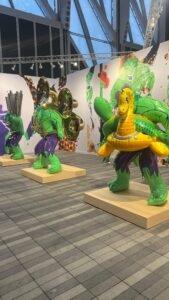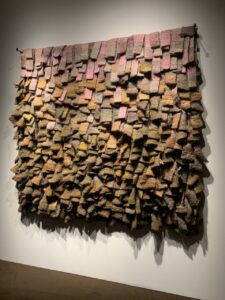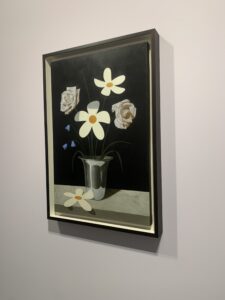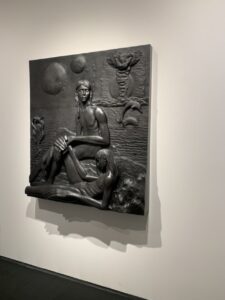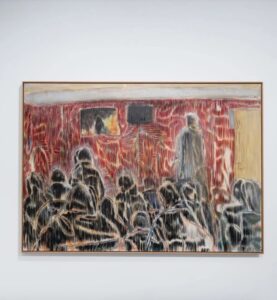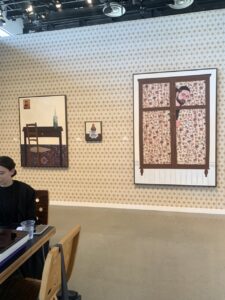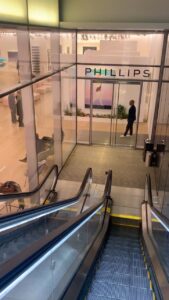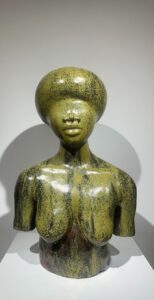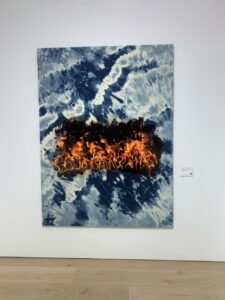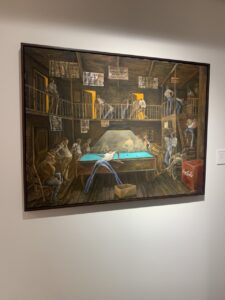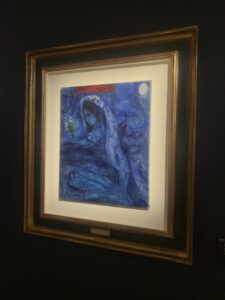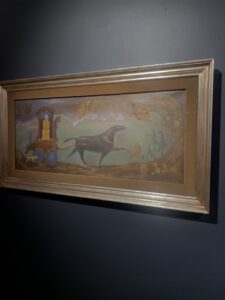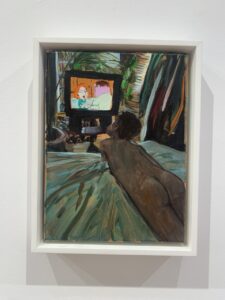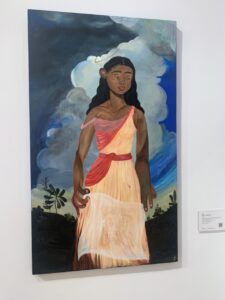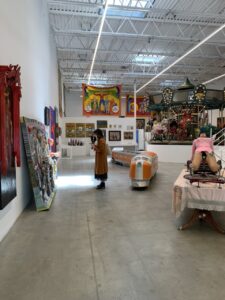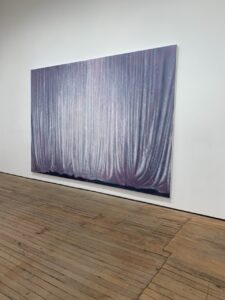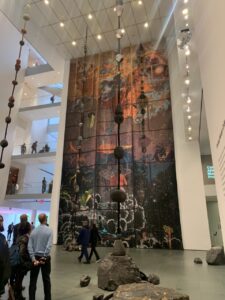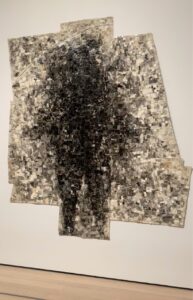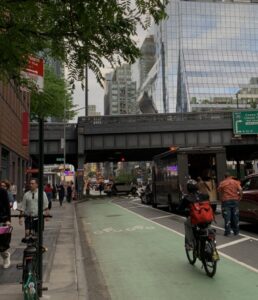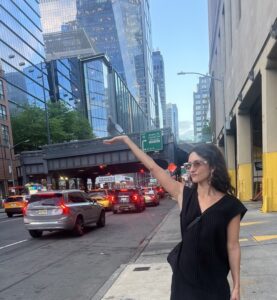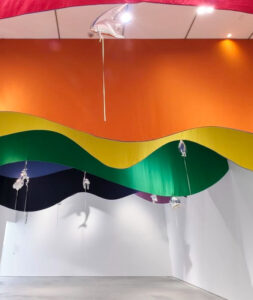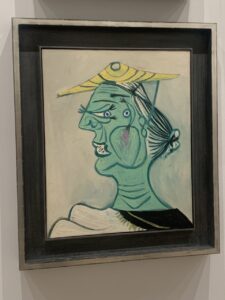NEW YORK ART WEEK / Spring 2025: How’s the Art Market Doing?
A VISIT TO THE ALLEGED ART MARKET CAPITAL DURING FRIEZE WEEK
– AND MY HUMBLE 2 CENTS
Intro:
My 1st and last time in NYC was about 10 years ago. It was a big wish I fulfilled with the first money I earned and saved after finishing school. I spent an amazing month in Manhattan and Brooklyn but I clearly remember it was in the middle of winter and days were snowy for real. When planning this trip with Leo Dorsch, my great friend and fellow art consultant, I thought: Great, this time it’s gonna be NYC in spring! And what better time to be there than spring? But life is life and it ended up being rainy af (what in the world was this humidity?). Of course, we still made the best of it. At one point I felt like Audrey Hepburn in Breakfast at Tiffany’s – you know the rain scene with the cat? (Sure, grandma, there there…) Well, we had a cat too but I’ll get to that.
Once we arrived to JFK, and after 2 hours of standing in line at border control (enough time to give space to slight doubts as to whether we’d be let in), we took an Uber to Manhattan. We felt blessed by a driver with sublime music taste who sang „Genie in a Bottle“ with us so loudly it made the traffic dissolve (more blessed for our mobile provider’s 50€ roaming cap that kicked in 30 min after leaving airport wifi). We checked into our – let’s call it – bohemian, old-NY artist hotel, where the rooms choose the visitors just like the wands choose the wizards in Harry Potter… and which may or may not be owned and managed by Banksy and Ned, his cat.
Expectations:
Some said the September Art Week in NYC, revolving around The Armory Show (also part of the Frieze group), is always bigger, more impressive, and attracts more people too. That might correlate with the fact that the autumn fair hosts far more galleries: Similar to the main Art Basel editions, The Armory Show counts over 200 exhibitors, whereas participants at Frieze NY this spring only amounted to 67.
This Art Week (May 5-11) promised to be different from recent years though, as the two big main fairs Frieze and TEFAF, normally spread out over two weeks, were now condensed into one. Meaning that left us with over 9 art fairs total, including the satellite fairs, countless gallery openings throughout the city, big ass institutional exhibitions, and the season’s most anticipated auction previews – all stuffed into one week. No need for more, really.
So, the key question wasn’t about quantity or scale, but more so program and quality. Our best friend in the art world, Jerry Gogosian (not to be confused with Larry Gagosian, the mega-gallerist), had predicted it. Or rather, cast doubt: Why would small and mid-size galleries even do art fairs during these ‘challenging times’? The noticeable decline in the art market is no news to anyone anymore and was popularly backed again by the newly published Art Basel and UBS Art Market Report 2025. How could the financial and emotional hassle of participating in fairs be worth it unless you’re Zwirner, Hauser & Wirth and co.? And what would the art fairs look like without said smaller exhibitors?
Speaking of worth: What were the sentiments around sales? Word on the street was, Americans are hesitant to buy, particularly under the uncertain reign of their new president. In other words, the market felt slow, everyone was being cautious – a word I’ve never heard people say more often in the same context. Not exactly breaking news. A sliver of hope was put on the upcoming marquee auctions: over $1 billion worth of art was expected to be sold in the Contemporary and Modern Art sales across the big 3: Christie’s, Sotheby’s and Phillips. The course of these auctions was meant to serve as an indicator for the current market’s condition.
Fairs:
We managed to visit 4 fairs: Frieze & NADA on Wednesday, TEFAF & Independent on Thursday. And still missed many: 1-54 Art Fair, Esther II, Spring Break Art Show, Future Fair, The Other Art Fair… I’d like to think it’s impossible to see them all. Still, I am sad I missed 1-54, a Contemporary African Art fair with 3 annual editions (Marrakech and London being the others). Another one that I stayed curious about is the alternative art fair Esther, which had received good reviews from colleagues.
Okay, but what can I say about the art fairs we did see? In terms of presentations, the bigger ones were overall a bit bland, especially compared to other recent fairs of similar caliber I’ve visited (Art Basel Miami Beach, Zona Maco). Even the Miami edition of NADA was better than this one, if you ask me. When asked about how he liked the fair, a befriended artist replied: NADA? It’s nada for me! (Haha, but also yes, I felt that.)
The winner (though there was no competition) must have still been Frieze but closely followed by Independent. And not only according to me – OG art critic Jerry Saltz said on IG that Frieze was the same as always, you love it and you hate it, but that Independent really had it in it. Indeed, if I had to say something off the top of my head, I’d say Independent provided some of the things that were missing at Frieze: disruption, novelty. Depth?
Most of the big-name Contemporary galleries were present at Frieze (and some at TEFAF), which is definitely a reason to go, as you can be sure to meet the main scene there. This is a great plus of these fairs. But the line-up just wasn’t it, the sauce was missing. And though each of us defines what makes a good fair differently, I think many in the art market share the same „truffle pig“ gene: they want to discover tomorrow’s hottest shit while it’s still unperceived by the masses, make a great deal on it and see it skyrocket in the course of the years to be able to tell everyone: I have seen it coming. And while this desire is increasingly visible in the current market, it didn’t feel satisfied at Frieze, at least not at this year’s edition. Maybe that’s not the fairs’ fault nor what they stand for at all.
But that was not the only bummer. Even many mega galleries didn’t seem to bring their A Game. Like they were holding back the good stuff for other fairs or later occasions. Don’t get me wrong, there were still incredible positions on view but the works, though aesthetically pleasing, overall didn’t feel all that impressive nor impactful. More like… J Game. (You decide what the J stands for.) I wonder if this impression was somehow favored by the venue Frieze NY is being held in (The Shed) and the fact that it has somewhat of a ‚shopping mall’ vibe to it. Art works presented at fairs already run the risk of coming across as mere products, commodities stripped off their soul being offered at a big bazaar and let’s just say this location doesn’t help.
Even though the main sentiment was slight disappointment (heavy on the slight because I am complaining at a high level), it would be delirious to say there weren’t gems in-between: Perrotin’s solo booth with Claire Tabouret for example, or Hannah Levy at Casey Kaplan… The ‚Focus‘ section at Frieze had actually quite some amazing outliers. I especially loved Danielle Brathwaite-Shirley’s interactive installation at the young London-based Public gallery. Not only did it stand out visually but to everyone’s pleasure, was also deeper in content, while sustainably engaging visitors (including Artsy and me).
Another one of Artsy’s „Top 10 Booths“ was Gagosian’s presentation of Jeff Koons’ infamous „Elvis Hulk“ sculptures. Rightly so? At least it was reportedly one of the fairs’ leading sales, with one of them sold for around $3 million during Preview hours. And it was probably the most talked-about booth – not necessarily the most important and if you ask me, by far not the best one but to quote Artsy: „you’re going to have an opinion on these works whether you want to or not.“ But let’s be so for real: Say we give in to the thought experiment and it was indeed the best booth – what does that say about this year’s Frieze NY? Controversial? Or basic?
Hyperallergic suggested the Koons display marked a turning point: that everybody at Frieze had stopped pretending to care about content and now focused purely on sales. Elaborating that the presentations were overall apolitical and thus not really relatable nor relevant. Or were the galleries adapting to the current market situation, trying to play it safe with works that would not offend anyone or feel like too big of a risk and thus could potentially be liked and purchased by greater audiences? Probably both. The winners in this imaginative competition were the few smaller galleries that went against the odds and shone even brighter with bold presentations. Seeing it from this perspective, maybe it can be worth participating in fairs for them after all.
Be that as it may, the previews were packed. TEFAF in particular felt crowded – according to the fair, attendance was up 11% from last year. Though way smaller than the Maastricht edition (around 90 exhibitors vs. 273), its traditional oysters and bubbles were still offered in narrow aisles. One thing about the art crowd: we love mingling at previews with a glass in hand. But during rush hours? I prefer standing still, because God forbid my drink lands on a Picasso and I land in jail. RuinART > ruinED.
TEFAF NY felt a bit more contemporary than Maastricht, which I appreciated. As someone who mainly works in emerging and Contemporary Art, this fair isn’t necessarily for me, with its focus on Modern Art, Old Masters, Antiquities, Jewelry and Design. A fun thing to see though was that even the contemporary positions on view leaned into art historical references (topics or techniques), trying to blend into the canon. Some personal standouts: Anne Imhof at Sprüth Magers, Anna Weyant at Gagosian, some wonderful works by Olga de Amaral at Richard Saltoun (among others), and a beautiful Julie Mehretu etching at White Cube to name a few.
Let’s be honest: expecting to like everything is delusional – true for museums, galleries and fairs alike. I’m happy if I like 20% of what I see, if it’s more, I’m thrilled. One fair that exceeded expectations in that regard was Independent, for all the reasons mentioned before: more exciting, brave, and encouraging curiosity, often focusing on promising positions and quality. I particularly loved the installation-like solo booth by Kiriakos Tompolidis at Galerie Judin, as well as Parliament’s booth with astonishing paintings by Achraf Touloub and Vistamare’s presentation of works by Rosa Barba, to also name a more established position.
If you want to see good art, I was told by a fellow art dealer, go to the marquee auction previews – and so I went. Phillips had managed to consign some amazing pieces, not to mention Christie’s (I didn’t make it to Sotheby’s). Was the art exhibited at Christie’s more impressive than most of what I had seen at TEFAF? Probably. And the concentration of moving works at Philips was higher than at Frieze. Everything according to my humble opinion, of course.
Auctions:
New York Art Week coincided with previews for the major May auctions for Contemporary & Modern Art throughout the 3 houses which were held the week after (beginning May 12). Altogether, the works heading to the block estimated at around $1 billion in sales. In a Bloomberg article, the outlook was being referred to as expectations being low, but the quality high – though still describing sales as „solid, if not spectacular“, and indicating towards a „mixed” market.
The art world was looking towards these marquee auctions as a much anticipated test for the market. Artnet editor Eileen Kinsella summed it up as „a very long giga-week of auctions that showed that there’s plenty of life in the art market“ while still having her foot on the bracket when comparing it to other previous years in terms of estimates, results, number of trophy works both offered and sold and the level of cautiousness. But see for yourselves:
PHILLIPS
The Modern & Contemporary auction was described as underwhelming, showing „low energy in the room“. It brought in $52 million, down from $86.3 million last year.
Nevertheless, 5 artist records were set, 4 of them for women, including Olga de Amaral. Go Olga! (Artnet)
CHRISTIE’S
A win: the 21st Century auction hit $96.5 million, surpassing last year’s $80.3 million. Post-War & Contemporary pulled in $66.5 million (vs. $75 million in 2024). The 20th Century sale made an additional $217 million (ARTnews).
Highlight: Marlene Dumas’ painting sold by the Rubell Collection set a new record for a living woman artist with $13.6 million. (Artnet)
SOTHEBY’S
Sales dropped: The Contemporary evening sale made $186.1 million instead of $234.6 million last year (Artnet). The Modern Art sale brought in $186.4 million, also down.
Worth mentioning is the Giacometti flop: one of the top lots of the season estimated at $70 million didn’t sell at all, which was seen by some as further proof the trophy market is weakening (Artnet). A development aligning with the Art Basel and UBS Art Market Report 2025 according to which the emerging, lower priced art sales are up whereas the blue-chip sales are down. Others argue the reserve (minimum selling price) might have been too high.
Exhibitions / Public Art:
Too many galleries (often with several locations each), too many museums, too many openings. Overwhelmingly many – better to accept early that it’s impossible to catch ’em all (yes, this is a Pokémon reference).
We managed to do some gallery hopping in SoHo/TriBeCa and found a high concentration of amazing shows: Jeffrey Deitch had a wild group show with a superstar lineup (refreshing to see something going beyond the classic white cube presentation); Louise Giovanelli at Grimm because I love this artist; and icon Salman Toor had two exhibitions at Luring Augustine, one exclusively with works on paper which was very poetic.
Museums? Some call it a „Hauser & Wirth spring“:
- Jack Whitten at MoMA – his works really unfolded their true magic when standing live in front of them.
- Rashid Johnson at the Guggenheim – almost omni-mediatic, towards a retrospective-leaning exhibition that we saw Day 1 and already knew it’d be a highlight.
- Amy Sherald at the Whitney – figurative paintings, also including the famous portrait of Michelle Obama. Missed it unfortunately.
- Lorna Simpson at the MET – promised to be very good but only opened after I had left the city.
All 4 are represented by the same mega gallery. Coincidence or not, let’s please normalize giving credit where credit is due.
Another standout Hauser & Wirth artist and popular topic of discussion: Thomas J. Price, with his larger-than-life sculpture of the girl next door in Times Square, „that foregrounds the intrinsic value of the individual and amplifies traditionally marginalized bodies on a monumental scale“. We went to check out his exhibition in the gallery’s SoHo space: a group of these incredible bronze sculptures of figures dressed casually and doing everyday things like checking their phones or looking around – inviting us to think about the power that representation, not only in the arts but in general, holds, and to assert who we should consider giving that power to.
Talking about public installations: we didn’t make it to The High Line (public sculpture path), but walking out of The Shed (Frieze) in direction of the Chelsea galleries, we did pass by one of my favorite public installations: the majestic Paloma, titled „Dinosaur“ by Iván Argote (if not Dinosaur, why Dinosaur named?). I would be really happy if his next big sculptural installation were a rat somewhere else in New York – but this might be too much to ask for, not sure (Iván, if you’re reading this, let’s work on this project together). Also, this might be random+, but if I were a rat I would definitely move to New York. Have you seen the trash bags piling up sideways on the streets?
Anyways, there were so many shows to see in Chelsea that we only checked out some of them: Rosemarie Trockel at Gladstone, Jeppe Hein at 303, Alicja Kwade at PACE – all of them great installations with a good deal of visitor experience! We also visited some of the Upper East Side galleries after checking out the Guggenheim and were wondering why Picasso had taken over the neighborhood: exhibited extensively at both Almine Rech and Gagosian.
Outro:
You want me to tell you the current art market is shit but that there’s a shimmer of hope, right? Not sure I can do that for you but I’ll give you this: Yes, the situation is shit, but it’s been shit before. And it’s come back before. If so many other cycles repeat, why not this one?
Still, I wouldn’t be surprised if the next market upswing comes with a little post-traumatic, glow-up correction. Right now, the market feels like a situationship sending mixed signals, breadcrumbing just enough to keep us holding on, to think it’s not so bad after all. The post-COVID love-bombing phase is over. Buyers and sellers are more cautious, less frivolous, rather hesitant. Sure, the market’s going through a lot. But we can only turn a blind eye so many times. After enough chances, maybe – just maybe – this new generation is flirting with real change. Down with the masters, long live the up-and-coming? I say let a new era begin.
© Images: all rights reserved by the respective artists, galleries, art fairs, and institutions mentioned in the captions and texts.

